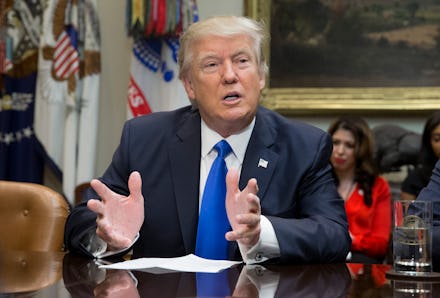Here are the checks and balances on President Trump's power — and how he's already undermining them

The president of the United States does not have the same power as a dictator or an autocrat. Strictly speaking, he or she doesn’t even have the same power as a prime minister in a parliamentary system like the United Kingdom or Canada.
President Donald Trump, though, seems to be looking to skirt the checks and balances built into U.S. constitution.
A quick civics lesson
There are three branches of government: executive, legislative and judicial. The executive branch is made up of the president and his picks to lead the various executive departments of government. The legislative branch consists of the House and the Senate. The judicial branch includes all federal courts, with the Supreme Court of the United States at the top.
The U.S. Constitution includes a series of “checks and balances” to assure that no branch gets too powerful. For instance, the legislative branch is supposed to make the laws, but the president gets to choose whether to sign or veto bills. Congress can in turn override a presidential veto. The judicial branch, meanwhile, can declare a law or executive order to be unconstitutional, but members of the federal bench are appointed by the president and confirmed by the Senate. Federal judges can also be impeached by the legislative branch, as can the president.
State and local governments also check the power of the president and the federal government in general through the American system of federalism, which reserves some government powers and functions for state and municipal governments.
With that trip back to high school over, let’s take a look at some of the ways Trump is flouting the limits placed on his powers just a few weeks into his time in the Oval Office — and why he’s not exactly alone among recent presidents:
Executive orders
Trump enacted 17 executive orders, including one that controversially cut off access to the United States for people from seven majority-Muslim countries for 120 days and placed an indefinite ban on refugees from war-torn Syria. Progressive groups were angered by the order and argued it was unconstitutional, not necessarily because it was an executive order but because it violated equal protection and religious freedom.
Former President Barack Obama also issued edicts on immigration via executive order. Some argued that this was executive overreach on the part of the Obama administration.
Presidents Ronald Reagan and George H.W. Bush also made executive orders regarding immigration.
Military operations
Technically, the only branch of government that has the power to declare war is the legislative branch. Yet since the end of World War II, the executive branch has waged war mostly unchecked. Trump has gotten off to a start that appears no different, authorizing a strike in Yemen.
The United States dropped more than 26,000 bombs in 2016. The left frequently criticized Obama for his policies on dropping bombs overseas
Going back even further, George W. Bush launched the Iraq War without a formal declaration of war, though he did have some official legislative support. This was not, though, an official declaration of war.
Threatening federal interference in Chicago
Here's one that is unique to Trump. Though the Obama administration did investigate some local police departments, Trump took it one step further, threatening on Twitter to send in federal agents to deal with violence in Chicago.
Ignoring court decisions
This is probably the most troublesome of Trump's actions to circumvent the separation of powers. Despite a court ruling placing a stay on Trump's immigration ban, the Department of Homeland Security says it is still enforcing the rule. This clearly flouts the judicial branches check on the executive.